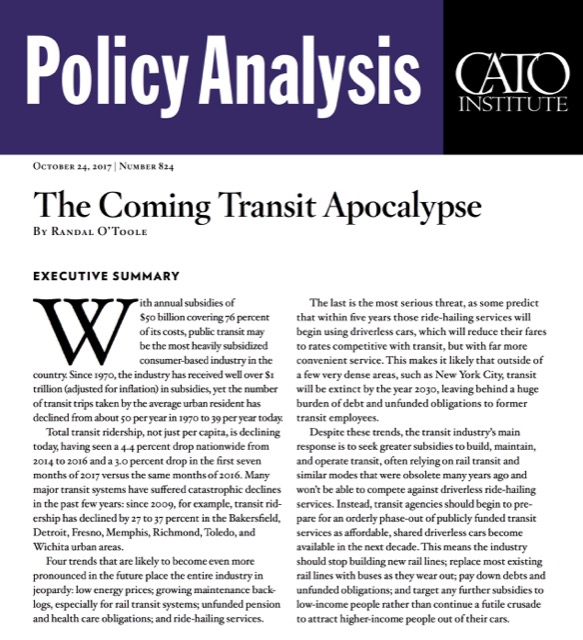The Coming Transit Apocalypse
From The Anti-Planner, October 23, 2017
Tomorrow (Tues Oct 24, 2017) , the Cato Institute will issue a new paper, The Coming Transit Apocalypse, predicting the end of public transit as we know it by 2030. Antiplanner readers can get a preview of this paper today by clicking on the image below.

Click image to download this paper.
Building on previous Antiplanner blog posts, the paper says the four horsemen of the transit apocalypse include:
- Low fuel prices;
- Ride-sharing services;
- Maintenance backlogs; and
- Unfunded pension and health-care liabilities.
The first two are causing transit ridership to drop and the second two are reducing transit agencies’ ability to respond to this drop. None of these are likely to change anytime soon, especially since transit agencies seem more interested in going further into debt building obsolete transit systems than in providing more innovative cost-effective transportation.
The real question is why we subsidize transit at all. It doesn’t help the poor. It isn’t particularly clean or energy efficient. Except in New York, it isn’t vital to urban or even downtown economies. Instead, we got into providing subsidies through a series of unrelated events and now can’t figure a way out.
If the paper’s prediction is correct, we won’t have to because transit is simply going to disappear, or it least its riders will. The danger is that, when transit agencies lose their customers, they’ll still have hundreds of billions of dollars in debts and unfunded liabilities. This is why it is important to begin now to plan the transition from publicly subsidized transit to private, and ultimately driverless, ride sharing.
If you are reading this Monday morning, the Antiplanner is on a train to Washington, DC (full report tomorrow). As noted last week, the Antiplanner will present a paper on the future of transit, making all of the above points, on Wednesday. I hope you can attend or watch on line.
|